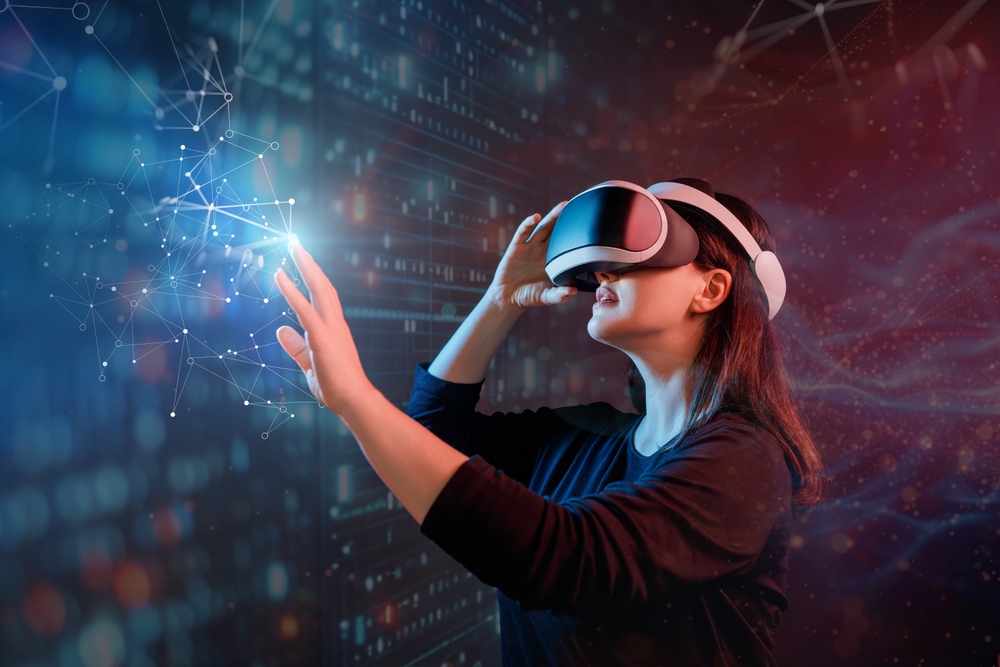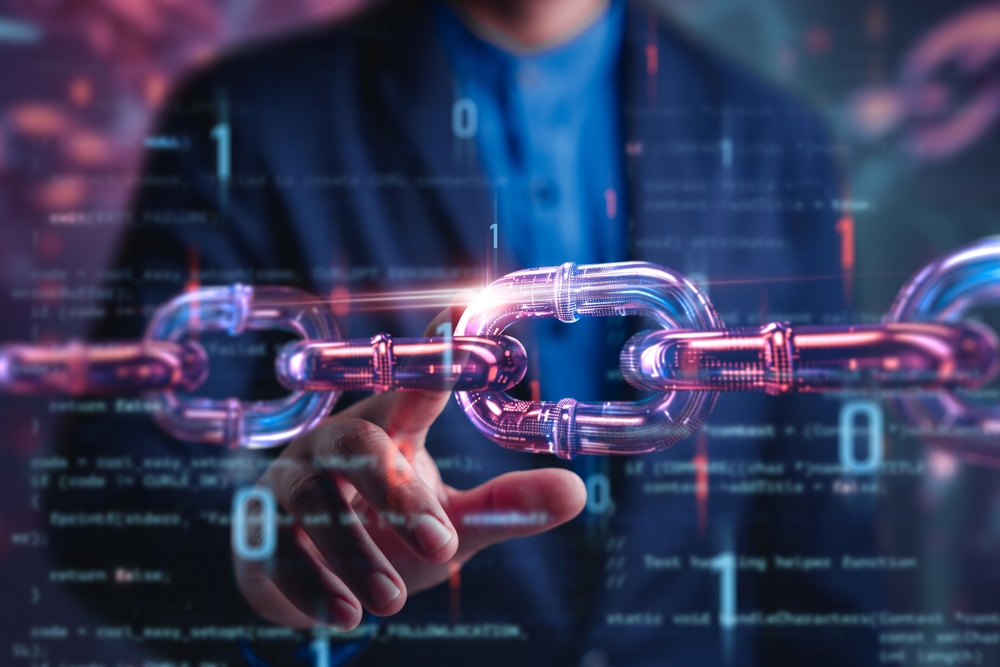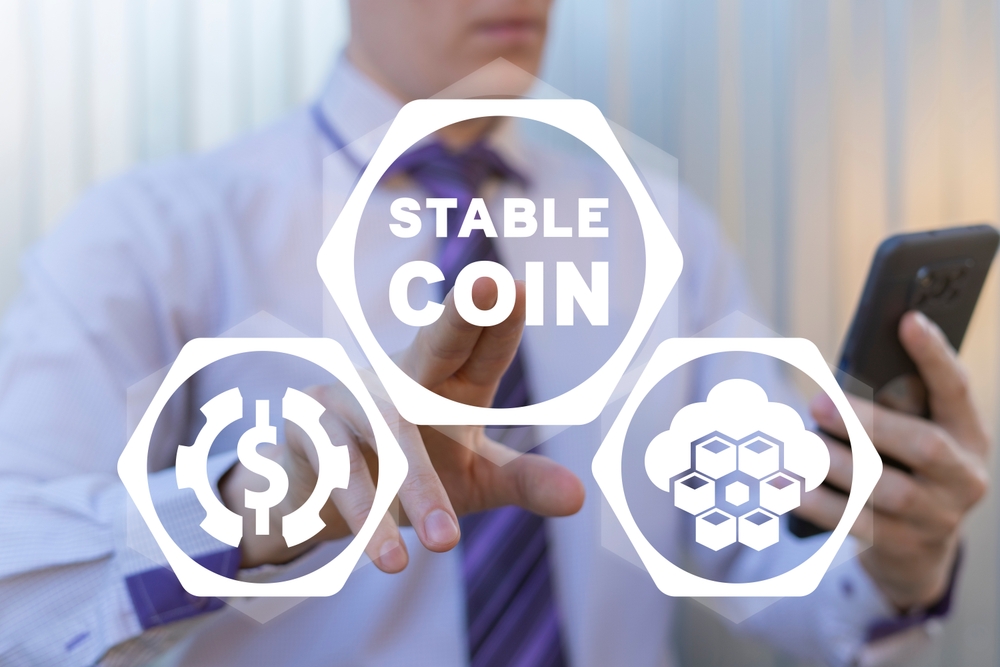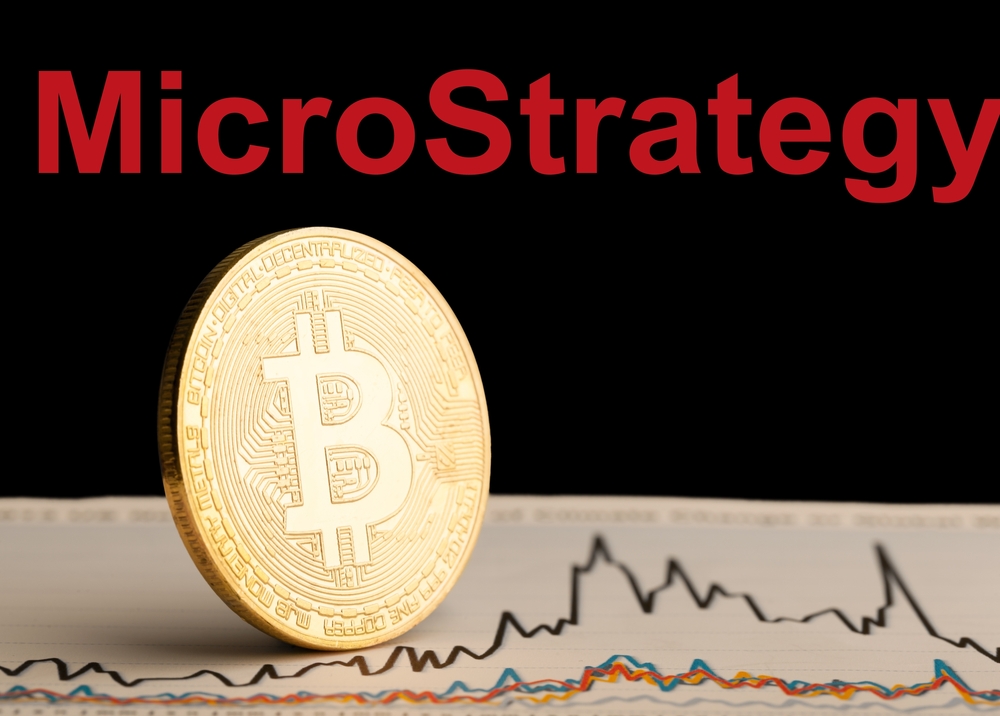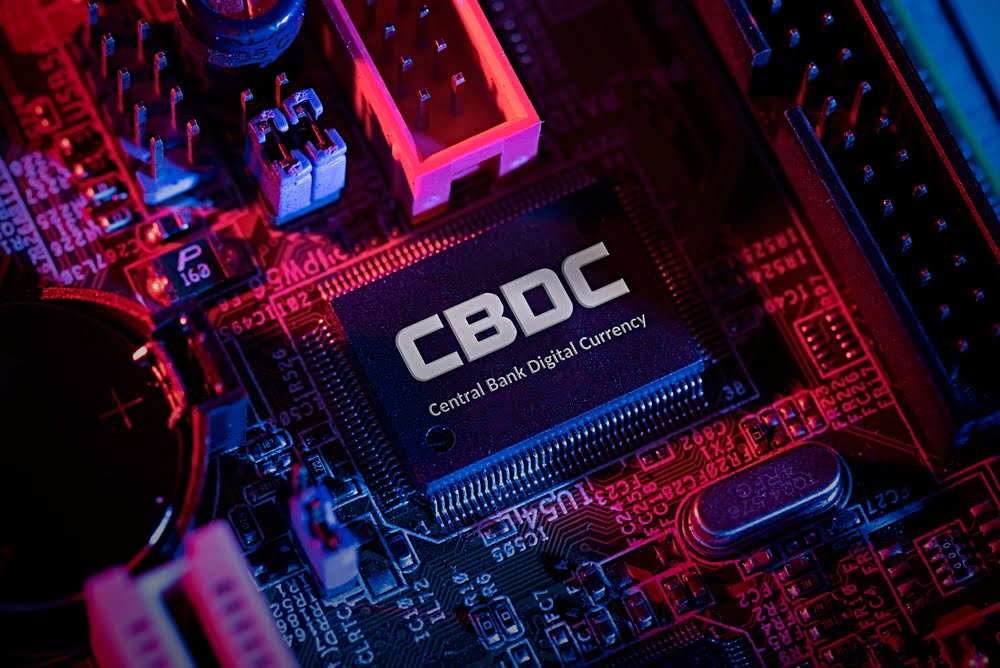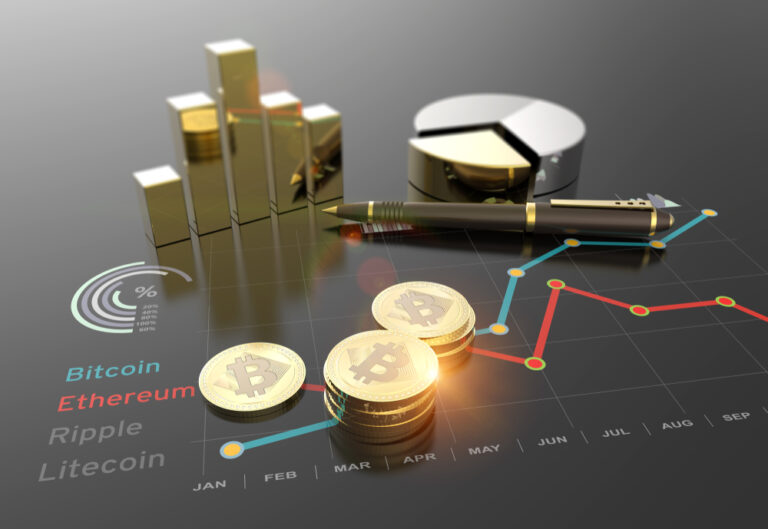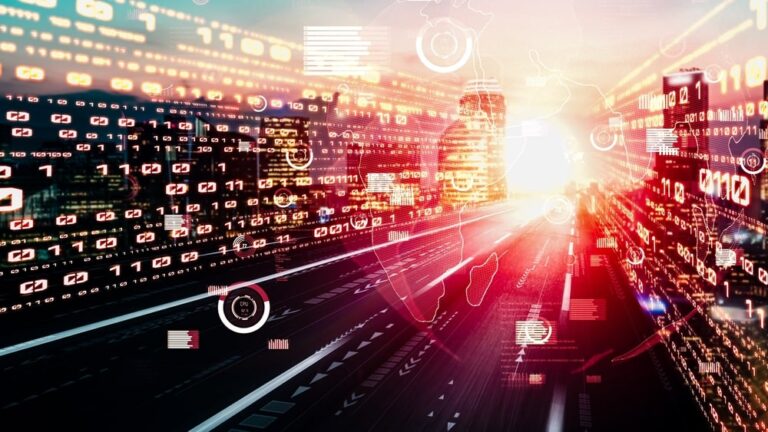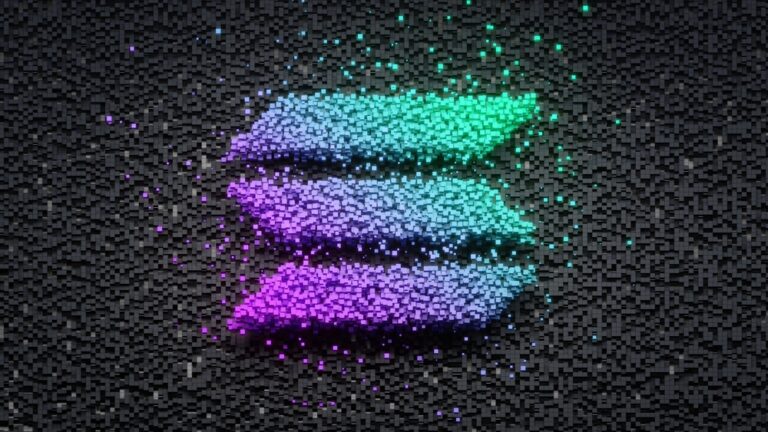Table of Contents
ToggleIntroduction
The worlds of augmented reality (AR), virtual reality (VR), and decentralized physical infrastructure networks (DePIN) are rapidly converging to create exciting new possibilities. DePIN, which focuses on integrating digital systems with physical infrastructure, is now expanding into immersive technologies. By 2026, experts predict that half of global enterprises will incorporate AR, VR, and blockchain technologies into their business strategies, signaling a major shift in how we interact with digital environments.

This technological convergence isn’t just changing entertainment and gaming—it’s transforming data workflows, business operations, and physical infrastructure. Companies like Auki Labs are pioneering machine perception technologies that bridge the gap between our physical world and digital experiences. The seamless integration of digital and physical realms through DePIN is creating new opportunities for developers, businesses, and consumers alike.
As AR and VR technologies mature, they’re finding natural synergy with decentralized networks, offering enhanced security, ownership, and interoperability. This partnership is proving especially valuable as DePIN touches virtually every industry, from healthcare and education to manufacturing and retail, creating more immersive, efficient, and trusted digital experiences.
Key Takeaways
- AR/VR technologies combined with DePIN are creating revolutionary new systems for integrating digital experiences with physical infrastructure.
- Enterprise adoption of these combined technologies is accelerating rapidly, with 50% of global companies expected to implement them by 2026.
- The convergence of immersive technologies and decentralized networks offers improved security, ownership, and practical applications across all major industries.
Evolution of AR/VR Technology

Augmented reality (AR) and virtual reality (VR) have transformed from experimental concepts to mainstream technologies through several decades of innovation. The journey spans from early head-mounted displays to today’s sophisticated systems that are reshaping industries like healthcare, gaming, and manufacturing.
Historical Milestones
The foundations of VR date back to the 1960s when Ivan Sutherland created the first head-mounted display called the “Sword of Damocles.” This bulky device could only display simple wireframe images but revolutionized how we thought about computer interfaces.
The 1990s saw major commercial attempts with Nintendo’s Virtual Boy and SEGA VR, though both failed to gain traction due to technical limitations and user experience issues.
AR concepts emerged in the early 1990s when Boeing researcher Tom Caudell coined the term “augmented reality” for a head-mounted display that helped factory workers assemble aircraft wiring harnesses.
The 2010s marked the true turning point with Oculus Rift’s Kickstarter campaign in 2012, followed by Google Glass introducing AR to the public consciousness. These projects demonstrated the potential for both technologies to move beyond niche applications.
Technological Advances
Display technology has progressed dramatically from low-resolution screens with limited field of view to high-definition displays offering immersive experiences. Modern headsets now feature resolutions approaching human visual acuity.
Tracking systems evolved from simple rotational tracking to full positional awareness using combinations of:
- Accelerometers and gyroscopes
- External cameras and sensors
- Inside-out tracking that eliminates external hardware
Computing power advancements enabled real-time rendering of complex environments, while markerless tracking technology now allows AR applications to recognize and augment real-world objects without special reference points.
Haptic feedback systems have developed to provide tactile sensations, further enhancing immersion by engaging multiple senses simultaneously.
Adoption Across Industries
Healthcare has embraced AR/VR for surgical training, patient education, and therapeutic applications. Surgeons use AR overlays during procedures for enhanced precision, while VR therapy helps treat phobias and PTSD.
The automotive industry employs AR and VR technologies throughout the design, manufacturing, and sales processes. Engineers visualize car designs in virtual spaces before physical prototypes, while customers can test drive vehicles virtually.
Education institutions increasingly incorporate these technologies for immersive learning experiences. Students can virtually dissect organisms, travel through historical sites, or practice dangerous procedures safely.
Entertainment and gaming remain the most visible applications, with VR headsets becoming more affordable and accessible. Mobile AR applications have reached billions through smartphone platforms, making augmented experiences a daily reality for many consumers.
Understanding DePIN

DePIN stands for Decentralized Physical Infrastructure Networks, a breakthrough model that combines blockchain technology with real-world infrastructure. This innovative approach is changing how physical networks are built, maintained, and governed while creating new opportunities for AR/VR technologies.
Concept and Significance
DePIN in crypto refers to networks where critical infrastructure is built, owned, and operated by communities rather than centralized entities. These systems use blockchain technology to coordinate resources, incentivize participation, and distribute rewards.
DePIN projects typically involve community members contributing physical resources like computing power, storage, or sensing equipment. In return, participants receive cryptocurrency tokens as rewards.
The significance of DePIN lies in its ability to create more resilient infrastructure. By distributing ownership across many participants, these networks reduce single points of failure and centralized control.
Blockchain-based management systems enable DePIN to govern physical assets efficiently while maintaining transparency and trust. This creates fairer economic models where value flows directly to those who contribute resources.
DePIN in Relation to AR/VR
AR/VR technologies benefit significantly from DePIN frameworks, particularly in creating the spatial data infrastructure needed for immersive experiences. Decentralized 3D mapping represents one powerful application, allowing communities to collectively build and maintain digital replicas of physical environments.
These collaborative mapping efforts provide the foundation for persistent AR experiences anchored to real-world locations. Users can contribute mapping data through everyday devices, earning rewards while enhancing the network’s capabilities.
DePIN models also solve critical AR/VR infrastructure challenges:
- Edge computing resources for low-latency processing
- Distributed storage for 3D assets and spatial data
- Verification systems for location-based experiences
By leveraging user-contributed resources, AR/VR developers can access more affordable infrastructure while users gain ownership stakes in the platforms they use. This creates alignment between platform success and community interests.
Hardware for AR/VR

AR and VR technologies rely on specialized hardware components to create immersive experiences. These tools work together to track movement, display virtual content, and enable user interaction in both virtual and augmented reality environments.
Head-Mounted Displays
Head-Mounted Displays (HMDs) serve as the primary viewing interface for AR/VR experiences. These devices come in two main varieties: standalone and tethered systems.
Standalone HMDs like the Meta Quest series contain built-in processing, eliminating the need for external computers. They offer freedom of movement but may have limited processing power compared to tethered alternatives.
Tethered systems like the Valve Index connect to powerful PCs, delivering higher-quality visuals and more complex experiences. The tradeoff comes in the form of cables that can restrict movement.
AR headsets such as Microsoft HoloLens overlay digital content onto the real world rather than creating fully immersive environments. These transparent displays allow users to see their surroundings while interacting with virtual elements.
Resolution, field of view (FOV), and refresh rate represent key specifications buyers should consider. Higher values generally provide more immersive and comfortable experiences.
Tracking Systems
Tracking systems monitor user movements to translate physical actions into virtual ones. Inside-out tracking uses cameras on the headset to map surroundings and determine position.
Outside-in tracking relies on external sensors placed around a play area. These high-quality hardware components offer precise positional data but require more setup.
Six degrees of freedom (6DoF) tracking allows users to move forward/backward, up/down, left/right and rotate along three axes. This creates more natural movement compared to 3DoF systems that only track rotational movement.
Modern tracking technologies incorporate sophisticated algorithms to minimize latency and prevent motion sickness. Some systems can now track individual finger movements, facial expressions, and eye movement.
Advanced AR systems use SLAM (Simultaneous Localization and Mapping) technology to create detailed environmental maps, enabling virtual objects to interact realistically with physical surfaces.
Input Devices
Input devices enable users to interact with virtual environments beyond head movements. Controllers are the most common input method, featuring buttons, joysticks, and trigger mechanisms.
Haptic feedback built into controllers provides tactile sensations that enhance immersion. Some systems deliver varying intensities of vibration to simulate different textures and interactions.
Hand tracking technology eliminates the need for physical controllers by using cameras to monitor hand and finger positions. This creates more intuitive interactions but may sacrifice precision.
VR accessories and peripherals include specialized equipment like VR treadmills, gloves with force feedback, and full-body tracking systems. These enhance immersion by allowing natural full-body movement.
Voice commands serve as another input method, especially useful in AR applications where users need to keep their hands free for real-world tasks while interacting with virtual elements.
Software Platforms for AR/VR

The AR/VR industry relies on robust software platforms for both development and deployment. These platforms provide the essential tools needed to create immersive experiences and manage content across devices.
Development Frameworks
Unity stands as one of the most popular development frameworks for AR/VR applications, offering a comprehensive suite of tools for creating interactive 3D content. The platform supports multiple devices and provides extensive documentation for developers.
Unreal Engine delivers high-fidelity graphics and sophisticated physics simulations, making it ideal for creating realistic AR/VR experiences. Developers appreciate its Blueprint visual scripting system that allows for rapid prototyping.
For mobile AR development, ARKit (iOS) and ARCore (Android) provide platform-specific tools that leverage device cameras and sensors. These frameworks enable features like surface detection, light estimation, and motion tracking.
Wikitude offers cross-platform SDK options for developers seeking to create applications that work across multiple devices and operating systems.
Content Management Systems
ArborXR leads the field as a top VR content management system, enabling organizations to deploy, manage, and scale VR applications across multiple devices. The platform provides remote device management capabilities that simplify fleet administration for businesses.
SynergyXR allows users to create and experience immersive 3D models in real time, specializing in collaborative environments. This platform makes it easier for teams to work together in virtual spaces regardless of physical location.
For social VR experiences, VRChat offers powerful tools for creating and sharing user-generated virtual worlds. The platform supports full-body tracking and custom avatars, fostering vibrant virtual communities.
Meta’s Spark AR has become a popular choice for creating AR filters and effects for social media platforms, with an intuitive interface designed for creators of all skill levels.
User Experience in AR/VR

The user experience in augmented and virtual reality environments requires specialized design approaches that accommodate spatial thinking and immersive interactions. These environments create unique challenges and opportunities for designers focused on creating intuitive, accessible, and meaningful experiences.
Design Principles
Effective AR/VR experiences follow key design principles that differ from traditional 2D interfaces. Spatial awarenessis fundamental – designers must consider how virtual elements interact with physical space in AR or create navigable environments in VR.
Cognitive load management remains critical as users can easily become overwhelmed in immersive environments. Designers should minimize unnecessary information and create clear visual hierarchies to guide attention.
Accessibility requires special consideration in these technologies. Not all users have the same physical abilities or comfort levels with spatial interfaces. Providing alternative interaction methods and adjustable comfort settings helps create inclusive experiences.
Consistency between real-world expectations and virtual behaviors creates intuitive interactions. When virtual objects behave as expected based on real-world physics, users adapt more quickly and experience less frustration.
Interaction Models
AR/VR interaction models have evolved significantly as the technology has matured. Gesture control allows users to manipulate virtual objects with natural hand movements, creating intuitive ways to select, move, and resize elements.
Gaze-based interactions track where users are looking to trigger actions or provide information. This approach works well for selections but must be carefully implemented to avoid accidental activations.
Voice commands complement other interaction methods by allowing hands-free control. They’re particularly valuable for AR and VR experiences when users need to perform complex actions or when their hands are occupied.
Controller-based input offers precision and tactile feedback that other methods may lack. Many VR systems use physical controllers with buttons, triggers, and haptic feedback to enhance the interaction experience.
Sensory Engagement
AR/VR experiences engage multiple senses to create immersive experiences beyond what traditional interfaces can achieve. Visual design in these spaces must consider depth, scale, and lighting to create believable environments and readable interfaces.
Audio design plays a crucial role in spatial orientation. 3D audio helps users locate objects outside their field of view and enhances the sense of presence in virtual spaces.
Haptic feedback provides tactile sensations that connect virtual interactions to physical feelings. Even simple vibrations can significantly improve user understanding of boundaries and interactions.
Movement and proprioception considerations help prevent motion sickness and disorientation. Designers must carefully manage user movement through virtual spaces, avoiding sudden perspective shifts and maintaining stable reference points.
AR/VR Content Creation

Creating compelling content for augmented and virtual reality requires specialized skills and tools. The process involves transforming ideas into interactive digital experiences that engage users in immersive environments.
3D Modeling and Animation
3D modeling forms the foundation of AR/VR content creation, allowing designers to build digital objects that appear realistic in virtual spaces. Artists use specialized software to construct detailed models with proper geometry, textures, and materials that respond correctly to virtual lighting.
Professional 3D modeling tools like Blender, Maya, and 3ds Max offer robust features for creating complex objects and characters. These tools support polygon modeling and sculpting techniques that provide precise control over virtual assets.
Animation brings these models to life through:
- Skeletal rigging
- Keyframe animation
- Motion capture integration
- Physics-based movement
The complexity of models must be carefully balanced against performance requirements. Too many polygons or high-resolution textures can cause lag in AR/VR experiences, especially on mobile devices.
Immersive content creation platforms now offer simplified workflows that allow even beginners to design and share AR creations without extensive technical knowledge.
Real-time Rendering Techniques
Real-time rendering is crucial for AR/VR experiences, as it generates images instantly in response to user movements and interactions. Unlike pre-rendered content, real-time rendering must process complex scenes at consistent frame rates (typically 60-90 fps) to prevent motion sickness.
Game engines like Unity and Unreal Engine have become the primary platforms for AR/VR development. These engines handle:
- Lighting calculations (global illumination, shadows)
- Physics simulations
- Spatial audio processing
- Interactive element responses
Optimization techniques such as level of detail (LOD) management and occlusion culling help maintain performance by reducing rendering workloads when objects are distant or hidden.
Advanced AR/VR technologies employ sophisticated rendering pipelines that account for various display types, from smartphone screens to specialized VR headsets. Each requires different approaches to projection, distortion correction, and color management.
Application Scenarios

AR/VR technologies and Decentralized Physical Infrastructure Networks (DePIN) are transforming how we interact with digital environments. These innovations create immersive experiences while leveraging decentralized networks to support physical infrastructure needs across multiple industries.
Gaming and Entertainment
The gaming sector has embraced AR/VR technologies most enthusiastically, creating immersive worlds where players can fully engage with digital content. Games like Pokémon GO demonstrate how AR can blend virtual elements with the real world, while VR headsets transport users to entirely new realms.
DePIN technologies enhance gaming experiences by enabling decentralized ownership of in-game assets. Players can invest in virtual real estate and truly own their digital items through blockchain verification.
Multiplayer experiences benefit from DePIN’s distributed infrastructure, reducing latency and server downtime. This creates more reliable gaming environments even during peak usage times.
Entertainment applications extend beyond gaming to include virtual concerts, art exhibitions, and social spaces where users interact through avatars in shared digital environments.
Education and Training
Educational institutions are adopting AR/VR to create interactive learning experiences that improve student engagement and knowledge retention. Complex concepts become easier to understand when visualized in 3D.
Medical students practice surgeries in VR simulations before working with real patients. Engineering students can disassemble virtual machinery to understand internal components without physical equipment.
Corporate training programs use these technologies for employee onboarding and skills development. VR simulations of dangerous workplace scenarios allow for risk-free practice of safety protocols.
DePIN supports these applications by providing modular design that adapts to different technical requirements, making deployment of educational tools more accessible to institutions with varying resources and needs.
Healthcare and Rehabilitation
Healthcare professionals use AR/VR for diagnostic visualization, surgical planning, and patient education. Surgeons can view 3D models of patient anatomy before making the first incision, improving surgical outcomes.
Rehabilitation programs leverage VR to make physical therapy more engaging and effective. Patients recovering from strokes or injuries perform therapeutic movements in gamified environments that track progress precisely.
Mental health treatment has been enhanced through VR exposure therapy for conditions like PTSD and phobias. Patients confront triggers in controlled virtual environments with therapist guidance.
DePIN contributes to healthcare applications by enhancing access to critical systems and ensuring patient data remains secure through decentralized storage solutions. This democratized approach improves healthcare delivery in underserved regions where traditional infrastructure is lacking.
Future Directions of AR/VR
The AR/VR landscape is evolving rapidly with new technologies reshaping how we interact with digital environments. These advancements are being driven by both emerging hardware innovations and deeper integration with complementary technologies.
Emerging Technologies
The AR/VR market is on track to reach $50.9 billion by 2026, showcasing substantial growth from the $13.8 billion recorded in 2022. This expansion is fueled by significant innovations in hardware and software.
Major tech players are leading the charge. Apple, Google, Samsung, and Meta are set to introduce groundbreaking advancements in headset technology by 2025. These developments focus on:
- Lighter, more comfortable headsets
- Extended battery life
- Higher resolution displays
- Wider fields of view
Future AR/VR devices will emphasize personalized, accessible experiences with improved design. The technology is moving toward more natural interaction methods, including eye tracking and gesture control.
Integration with AI and IoT
AR/VR is increasingly merging with artificial intelligence and Internet of Things (IoT) ecosystems, creating more intelligent and responsive experiences.
AI integration enables context-aware AR/VR that can interpret environments and user behaviors in real-time. This creates more intuitive interactions and personalized content delivery based on:
- User preferences and history
- Environmental conditions
- Task requirements
For businesses, this integration is transforming operations by enabling:
- Virtual product demonstrations with unlimited presentation possibilities
- Remote collaboration with realistic presence
- Data visualization in three-dimensional space
IoT sensors feed real-world data into AR/VR systems, creating digital twins of physical environments that update in real-time. This synchronization between digital and physical worlds opens new possibilities for industrial monitoring, smart cities, and enhanced retail experiences.
Challenges and Limitations
Despite the promising integration of AR/VR with DePIN networks, several important barriers remain before widespread adoption can occur. These challenges affect both technology implementation and user experience across multiple dimensions.
Privacy and Security
AR/VR devices collect vast amounts of personal data, creating significant privacy concerns when integrated with DePIN networks. These devices can track eye movements, map physical spaces, and record user behavior patterns—all valuable information that requires robust protection.
Security vulnerabilities exist at multiple levels. The decentralized nature of DePIN adds complexity to securing user information, as data flows through numerous nodes rather than a single protected server.
Hacking risks are particularly concerning because AR/VR devices can provide access to users’ physical surroundings and biometric data. If compromised, attackers could potentially:
- Access personal visual feeds
- Manipulate displayed information
- Extract location data
- Interfere with DePIN transactions
Current solutions like encryption and secure authentication protocols remain imperfect, especially as processing limitations in AR/VR devices can restrict implementation of comprehensive security measures.
User Accessibility
The high manufacturing costs of AR/VR hardware create significant barriers to entry. Quality headsets and glasses remain expensive, limiting adoption among potential DePIN network participants.
Technical complexity presents another hurdle. Many AR/VR applications feature confusing user experiences and steep learning curves, restricting participation to tech-savvy individuals.
Physical limitations also affect accessibility. Current-generation devices tend to be:
- Bulky and uncomfortable for extended wear
- Battery-limited for mobile applications
- Potentially disorienting or nauseating for some users
- Difficult to use alongside traditional tools
Network requirements compound these issues. DePIN applications demand reliable, high-bandwidth connections that aren’t universally available, creating geographic and economic divides in access.
Ethical Considerations
Content moderation in decentralized AR/VR environments presents unique challenges. Without centralized oversight, harmful or misleading content can spread rapidly through DePIN networks.
The technology raises questions about information manipulation. AR overlays can alter users’ perception of reality, potentially creating opportunities for deception when combined with decentralized verification systems.
Digital divides may widen as AR/VR-enabled DePIN applications advance. Communities lacking access to necessary hardware, software, or technical knowledge risk being excluded from emerging economic opportunities.
Environmental impacts warrant consideration too. AR/VR hardware production involves rare earth minerals and energy-intensive manufacturing processes, while running DePIN networks requires significant computational resources and electricity consumption.
Regulatory frameworks remain underdeveloped for these emerging technologies, creating uncertainty around liability, content standards, and user protections in decentralized environments.
Market Trends and Economic Impact
The AR/VR market is experiencing significant growth with revenue projected to reach $46.6 billion worldwide in 2025. This expansion is driven by technological advancements and increasing demand across multiple sectors, with substantial investment flowing into both established companies and emerging startups.
Industry Forecasts
The global AR and VR market is projected to reach $46.6 billion in 2025, with continued growth expected through 2029. This represents a major increase from previous years, demonstrating the technology’s increasing market penetration.
AR/VR technologies are seeing rapid adoption across healthcare, education, retail, and entertainment industries. The consumer segment remains strong, but enterprise applications are growing faster as businesses implement immersive solutions for training, design, and customer engagement.
The U.S. market specifically shows rapid growth and innovation, with American companies leading many technological breakthroughs. Industry experts anticipate the global market will exceed $96 billion by 2029, representing a compound annual growth rate of approximately 34%.
Investment Analysis
Investment in AR/VR technologies continues to increase as venture capital firms and major tech companies recognize the potential for significant returns. Funding has diversified beyond gaming applications to include enterprise solutions, healthcare innovations, and DePIN (Decentralized Physical Infrastructure Networks) integration.
The convergence of AR/VR with blockchain technology is creating new investment opportunities, particularly in decentralized applications that leverage immersive experiences. This has attracted both traditional tech investors and crypto-focused funds.
Hardware investments remain substantial, with companies developing next-generation headsets, haptic devices, and spatial computing platforms. However, software and content development are seeing the fastest growth in investment allocation.
Major technology companies have committed billions to AR/VR development, recognizing these technologies as critical components of future computing platforms. This corporate backing provides market stability and accelerates innovation across the ecosystem.
Frequently Asked Questions
AR/VR technologies raise many important questions as they become more integrated with decentralized physical infrastructure networks. These questions cover everything from basic technology differences to specific applications and development challenges.
How do augmented reality (AR) and virtual reality (VR) technologies differ?
Augmented Reality (AR) overlays digital content onto the real world, while Virtual Reality (VR) creates a completely immersive digital environment. AR enhances reality by adding digital elements to what you see, typically through smartphones or special glasses.
VR replaces the real world entirely with a simulated one using headsets that block out physical surroundings. Both are part of extended reality (XR), which encompasses various immersive technologies.
The key difference lies in immersion level – AR maintains connection with reality while VR transports users to entirely different environments.
What are the potential applications of AR and VR in healthcare?
AR/VR technologies are transforming healthcare through surgical planning, medical training, and patient care. Surgeons use AR overlays during operations to visualize critical structures beneath tissue, improving precision.
Medical students practice procedures in VR simulations before treating real patients, reducing risks and accelerating skill development. For patients, VR provides pain management alternatives through immersive distraction therapy.
Therapy applications include treating PTSD, phobias, and anxiety disorders through controlled exposure in virtual environments. Remote consultations benefit from AR tools that enable doctors to annotate what they see during video calls.
What are the skills required to become an AR and VR developer?
AR/VR developers need strong programming skills, particularly in C#, C++, or JavaScript. Understanding 3D modeling and spatial computing concepts is essential for creating immersive experiences.
Knowledge of development platforms like Unity, Unreal Engine, ARKit, or ARCore provides the foundation for building applications. UI/UX design skills specific to spatial environments help create intuitive interfaces that work in three dimensions.
Mathematical aptitude, particularly linear algebra and trigonometry, supports the complex calculations needed for tracking and rendering. Problem-solving abilities are crucial as developers work with evolving technologies and overcome hardware limitations.
What is the expected progression of virtual reality technology over the next decade?
VR technology will likely see dramatic improvements in display resolution and field of view, creating more realistic visuals. Headsets will become lighter, wireless, and more comfortable for extended use periods.
Haptic technology will advance to provide more convincing physical feedback, allowing users to “feel” virtual objects. AI integration will create more responsive virtual environments with believable NPCs (non-player characters) that adapt to user behavior.
Social VR experiences will expand, creating spaces where people interact naturally with realistic avatars. Enterprise adoption will accelerate as ROI becomes clearer across training, design, and collaborative applications.
How are AR and VR shaping the future of education and training?
AR and VR are revolutionizing training methods by providing immersive, hands-on learning experiences without real-world risks. Students can explore historical sites, conduct dangerous science experiments, or practice surgical procedures safely.
Corporate training benefits from VR simulations that develop soft skills through realistic scenarios with virtual humans. Retention rates improve as immersive experiences create stronger memory associations than traditional learning methods.
AR enhances textbooks and classroom materials with interactive 3D models that students can manipulate and explore. Distance learning becomes more engaging when students share virtual spaces rather than video calls.
What are the key challenges in developing AR and VR content?
Hardware limitations present significant challenges for AR/VR development, including processing power, battery life, and display quality. Motion sickness remains an issue for VR users when visual and vestibular inputs don’t match perfectly.
Content creation costs are high due to specialized skills required and the complexity of developing 3D assets. Cross-platform compatibility is difficult as developers must optimize for various devices with different capabilities.
User interface design requires new paradigms since traditional 2D interfaces don’t translate well to spatial computing. Privacy and security concerns emerge as these technologies can capture unprecedented data about users’ environments and behaviors.

